by Christine Huskisson
I walked into the M S Rezny Gallery located in the proposed Distillery District of downtown Lexington, Kentucky and immediately thought the exhibit Connecting Fibers was challenging. There is some fine work here, but I had to question why I felt so bothered. On one hand, the exhibit acknowledges the status that fiber art has attained over the years. On the other hand, it denies it by returning us to the age-old debate of art versus craft.
This debate began centuries ago about what objects held sway as “fine” art versus those relegated to a lower echelon often referred to as the art or craft of working in particular medium that was more functional – such as fiber. For many years, music, poetry, painting, and sculpture were permitted to hold the title of fine art, but by the 1970s this ordering principle began to erode and by the 90s all such hierarchical categorizations collapsed.

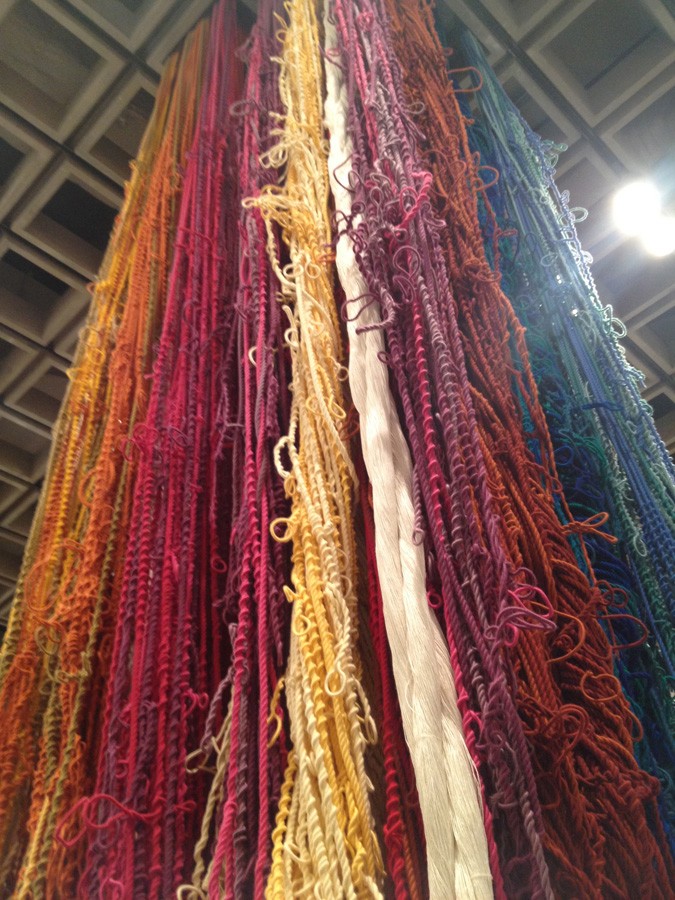
This year, in fact, fiber played a significant role in one of the most reputable shows of contemporary art in America. As a significant part of the 2014 Whitney Biennial, visitors excitedly consumed a 90-foot column of yarn hanging from the ceiling of the fourth floor of the Whitney Museum of American Art.
Sheila Hicks’ Pillar of Inquiry/Supple Column fell prominently amidst numerous abstract expressionist paintings, but was by no means attempting to be a painting. In the ever growing expanse of contemporary art it has become far more important to introduce innovative works that expand a conversation in cultural relativism.
Back in Lexington, Kentucky, it seemed to me that the strategy employed to collect the work in Connecting Fibers – and possibly the intentional perfection of an installation style that harkened back to the white cube of a museum where paintings and sculpture were staged – posed the risk of obstructing us from simply considering what each of these artists contributes to our current discourse. For the most part, I would argue, that was not accomplished within the artists’ “exploration of color, or form, or line as painters and sculptors” (from the exhibition press release), but rather in the artists’ awareness of much broader issues.
Connecting Fibers includes six regional fiber artists: Stacey Chinn, Justine Dennis, Janice A. Durham, Arturo Alonzo Sandoval, Laverne Zabielski and Jennifer Zurick.
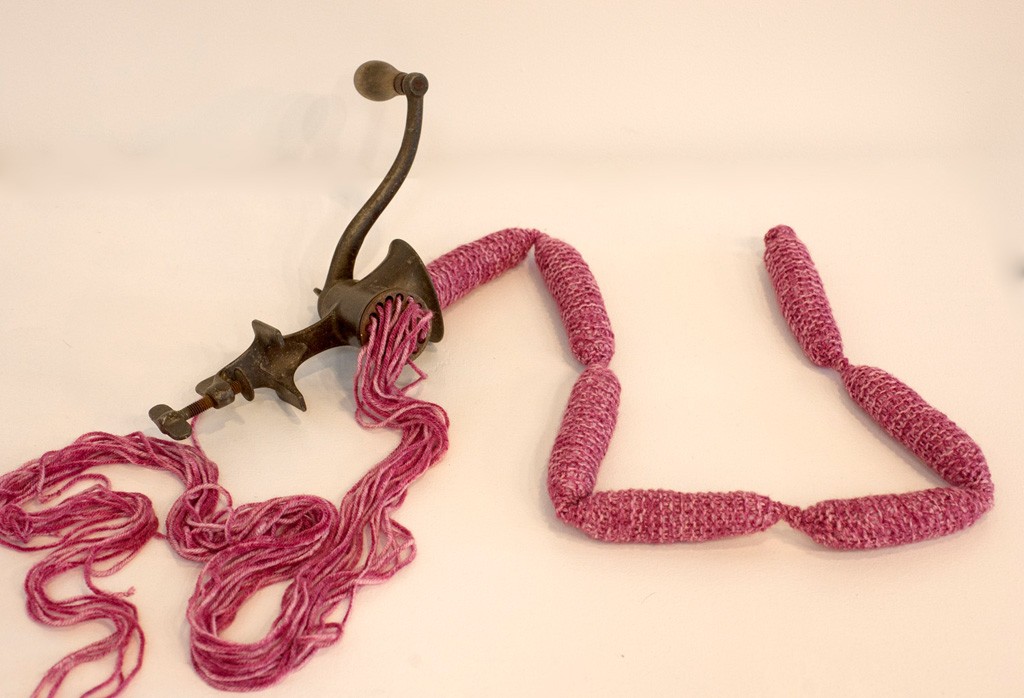
Chinn, for example, is well aware of important precedents in the art world. It’s What’s for Dinner brings to mind the work of artist Judy Chicago, an American feminist who challenged not only the role of women in art, but the role of materials and techniques that were for so long considered simply ‘women’s work’. Chicago’s The Dinner Party from 1979, which was a triangular table with fifty-five place settings – each paying homage to crafts like sewing, ceramics, and fiber and the women who worked in these disciplines, is a critical marker in the art versus craft debate. Chicago provoked in order to legitimize or elevate craft to a higher form of art. Today, Chinn needs no such strategy; she is free to comment further on the role the materials and the maker play – or does not play – in the creation of art.
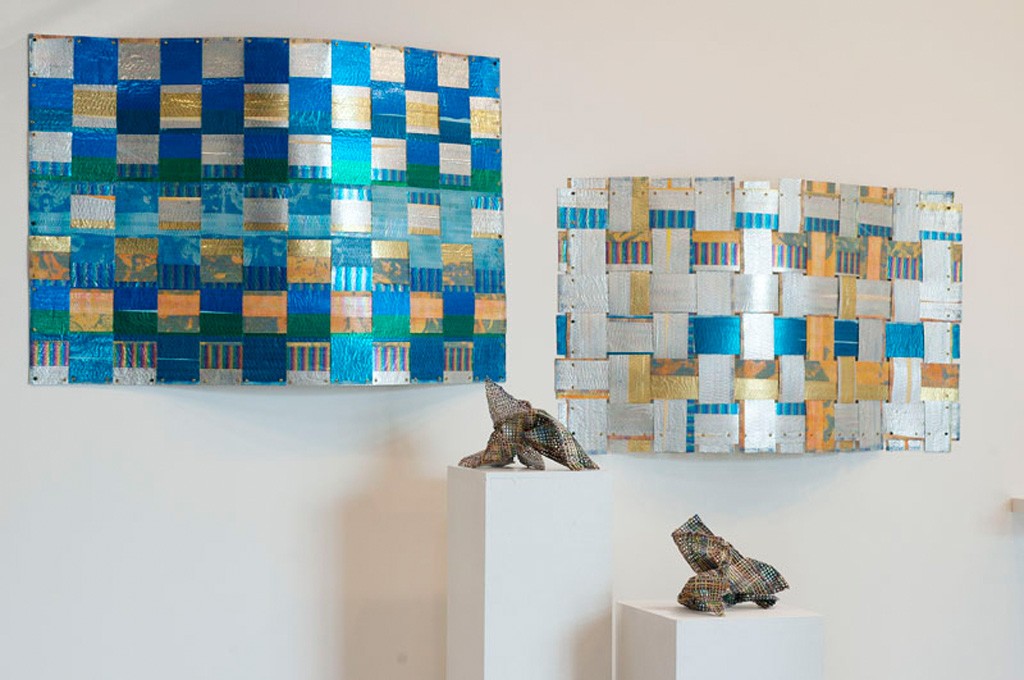
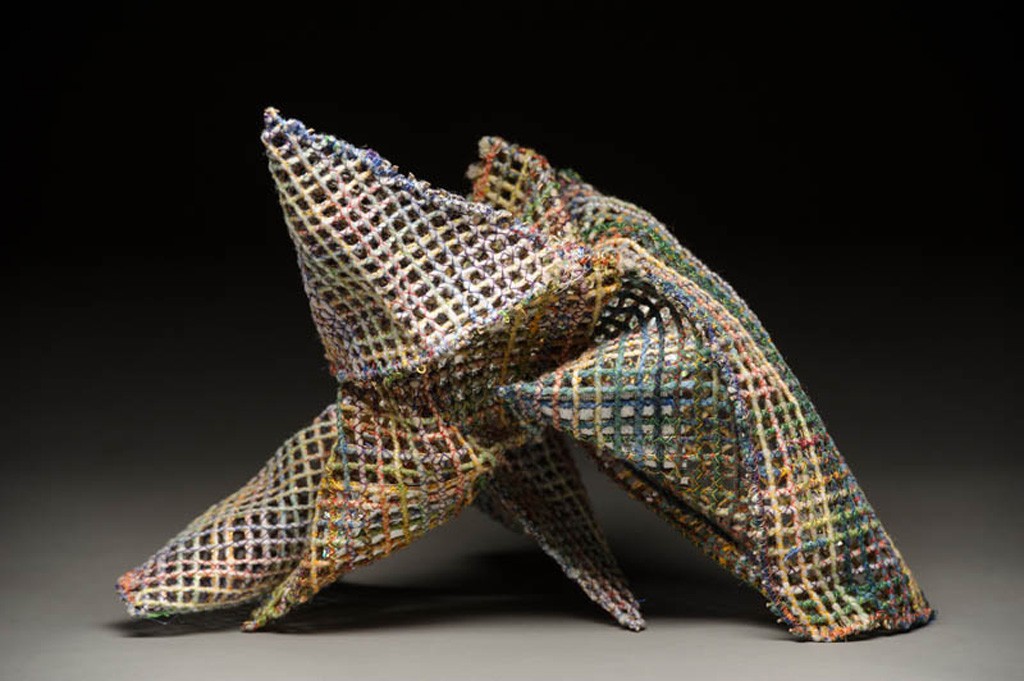
Arturo Sandoval is a renowned contemporary fiber artist best known for his weavings of industrial materials and lengths of found film that often display as wall-hangings on a massive scale. For this exhibit he has created two small fiber-stitched grid sculptures titled “Homage To Tony Smith No. 1 and No. 2” along with his interlaced fiber wall hangings titled “Confluence: Landscape No. 1 and No. 2”.
Sandoval’s homage to Tony Smith seems immensely prescient in this context. By referencing the work of the American Minimalist sculptor, Sandoval both admits to the early schism between the repute of his chosen medium and that of most minimalist sculptors. At the same time, Sandoval denies that there is a divide by addressing the topic in such a cursory manner – confidently manipulating mesh netting into what appear more like maquettes than a final work of art, certainly the final creation of any minimalist sculptor that is.
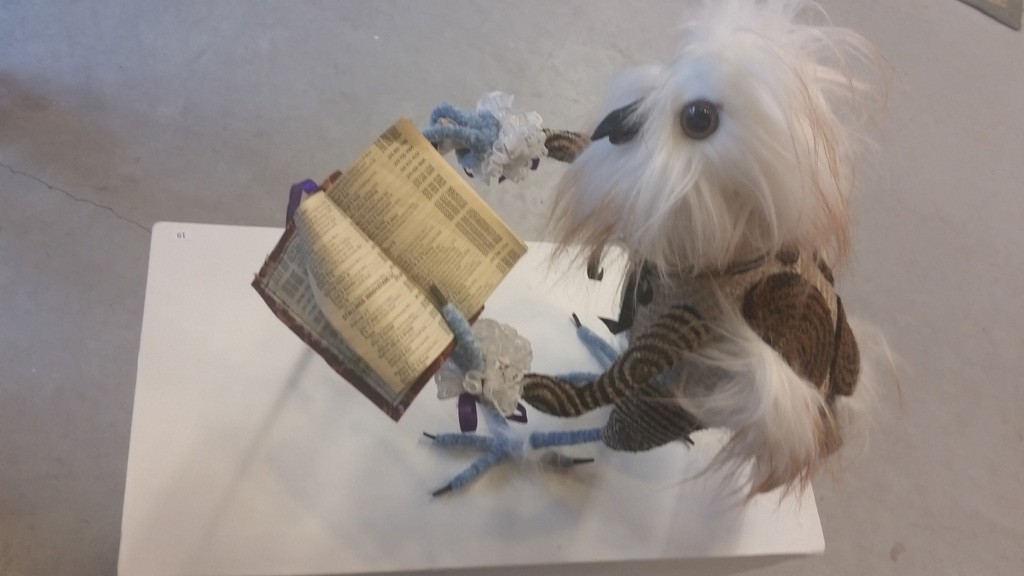
Justine Dennis acknowledges the role of storytelling and a reliance on narrative in contemporary art. Albert Eaglestein, one of Dennis’ small creations, had me pondering my trepidation about reopening a discussion many thought was closed – or had to be closed – in order to gain higher ground. Eaglestein’s ancient tome is the Telephone Directory as noted in the wall text:
Another stage, another moment of fiborcity. From out of the wings, Albert Eaglestein moves to hold court. Surrounded by his flock of adoring acolytes he stands erect, with his own degree of proud assuredness and, supporting himself on his primeval twisted cane, he postulates once again upon the deeper meanings of the Telephone Directory,
This ancient tome has been handed down to him through generations of Eaglesteins, none of them with any greater understanding of the work than he has. He is simply aware of the great meaning of it to those in days gone by who would frequently consult the works for the answers to long forgotten questions.
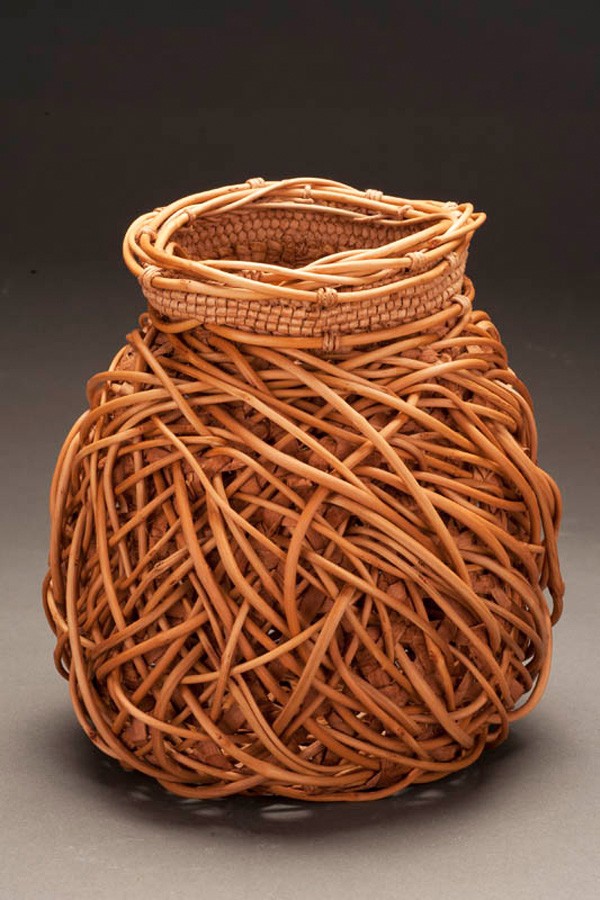
The narrative provided with this piece made me wonder if even inciting: ‘oh, it’s the age-old art-versus-craft debate’ is not an ancient tome in and of itself. Is there some value in revisiting ‘long forgotten questions’ and for that matter answers? Should we return on occasion to that which we thought we knew?
Jennifer Heller Zurick’s woven vessels are from a series titled Entwined. Do these small vessels need a pedestal to elevate them from a willow bark basket to an aesthetic object with unique merit? Zurick’s masterful technique of weaving itself raises a broader question about the absence of discernible skill in much of what we call contemporary artistic practice. Could we discuss what was once an intentional move toward de-skilling and consider what impact that has had and will continue to have?
Do these small vessels need a pedestal to elevate them from a willow bark basket to an aesthetic object with unique merit?

It might be important to note, for instance, that critics of Hick’s massive column of yarn that hung in the Whiney Biennial referenced a work that they found to be much more successful because it contains some reference at least to the mark of the artist’s hand in its creation. It was exhibited at the same time as the biennial just across town in Cheslea at the Sikkema Jenkins Gallery. In that piece, titled Lares and Penates, Hicks returns to the use of an intricate form of hand wrapping found objects.
Laverne Zabielski uses the Shibori technique for dyeing felted wool to create pieces with titles that include: A Narrative Line, Red Intention, Bordeaux Connections, Perseverance Plays. It was difficult to see past the attempt to equate these works – albeit it on a much smaller scale – with those of the abstract expressionists, particularly the color field painter Helen Frankenthaler. Like many abstract expressionist paintings, these wall-hangings were aesthetically pleasing and imbued with deeper meaning accessible only by title. I had a difficult time with what seemed an attempt to elevate these works to the status of painting, when that no longer matters.
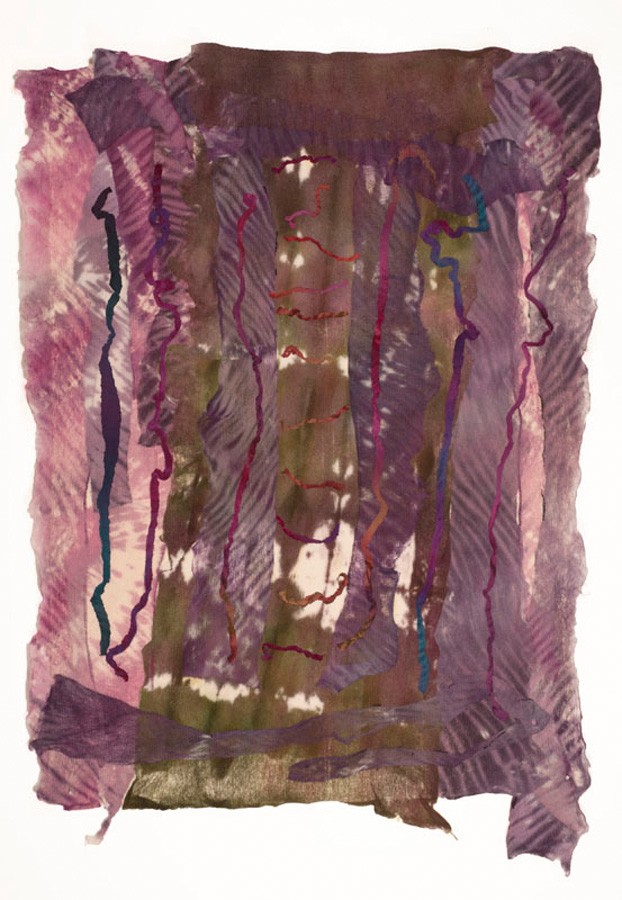
Zabielski’s fourth piece however is purposefully placed on the floor. It irked me to no end, because I wanted to know just what the artist believed: is it this or is it that? I found myself wishing we could talk again about art versus craft and the function art plays in our lives.
In fact, I think that the curator of this show – perhaps unknowingly – reignites the conversation. For that reason, I think it is worth a visit. Isn’t art, after all, simply a construction of our discourse about it?
Exhibit on view through October 2014.
Connecting Fibers: fiber as art and sculpture
Stacey Chinn, Justine Dennis, Janice A. Durham, Arturo Alonzo Sandoval, Laverne Zabielski and Jennifer Zurick
October 2nd-31th , 2014
Gallery Hours are Tuesday-Friday11am-4pm, Saturday noon-3, and by appointment.
